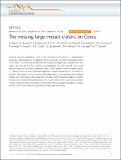The missing large impact craters on Ceres
Author(s)
Marchi, S.; Raymond, C. A.; Fu, R. R.; O’Brien, D. P.; Bland, M. T.; Ammannito, E.; De Sanctis, M. C.; Bowling, T.; Schenk, P.; Scully, J. E. C.; Buczkowski, D. L.; Williams, D. A.; Hiesinger, H.; Russell, C. T.; Ermakov, Anton; ... Show more Show less
DownloadThe missing large.pdf (3.799Mb)
PUBLISHER_CC
Publisher with Creative Commons License
Creative Commons Attribution
Terms of use
Metadata
Show full item recordAbstract
Asteroids provide fundamental clues to the formation and evolution of planetesimals. Collisional models based on the depletion of the primordial main belt of asteroids predict 10–15 craters >400 km should have formed on Ceres, the largest object between Mars and Jupiter, over the last 4.55 Gyr. Likewise, an extrapolation from the asteroid Vesta would require at least 6–7 such basins. However, Ceres’ surface appears devoid of impact craters >∼280 km. Here, we show a significant depletion of cerean craters down to 100–150 km in diameter. The overall scarcity of recognizable large craters is incompatible with collisional models, even in the case of a late implantation of Ceres in the main belt, a possibility raised by the presence of ammoniated phyllosilicates. Our results indicate that a significant population of large craters has been obliterated, implying that long-wavelength topography viscously relaxed or that Ceres experienced protracted widespread resurfacing.
Date issued
2016-07Department
Massachusetts Institute of Technology. Department of Earth, Atmospheric, and Planetary SciencesJournal
Nature Communications
Publisher
Nature Publishing Group
Citation
Marchi, S. et al. “The Missing Large Impact Craters on Ceres.” Nature Communications 7 (2016): 12257.
Version: Final published version
ISSN
2041-1723